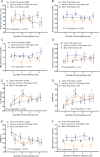Sedentary time and cardio-metabolic biomarkers in US adults: NHANES 2003-06
- PMID: 21224291
- PMCID: PMC3634159
- DOI: 10.1093/eurheartj/ehq451
Sedentary time and cardio-metabolic biomarkers in US adults: NHANES 2003-06
Abstract
Aims: Prolonged sedentary time is ubiquitous in developed economies and is associated with an adverse cardio-metabolic risk profile and premature mortality. This study examined the associations of objectively assessed sedentary time and breaks (interruptions) in sedentary time with continuous cardio-metabolic and inflammatory risk biomarkers, and whether these associations varied by sex, age, and/or race/ethnicity.
Methods and results: Cross-sectional analyses with 4757 participants (≥ 20 years) from the 2003/04 and 2005/06 US National Health and Nutrition Examination Survey (NHANES). An Actigraph accelerometer was used to derive sedentary time [< 100 counts per minute (cpm)] and breaks in sedentary time. Independent of potential confounders, including moderate-to-vigorous exercise, detrimental linear associations (P for trends < 0.05) of sedentary time with waist circumference, HDL-cholesterol, C-reactive protein, triglycerides, insulin, HOMA-%B, and HOMA-%S were observed. Independent of potential confounders and sedentary time, breaks were beneficially associated with waist circumference and C-reactive protein (P for trends <0.05). There was limited evidence of meaningful differences in associations with biomarkers by age, sex, or race/ethnicity. Notable exceptions were sex-differences in the associations of sedentary time and breaks with HDL-cholesterol, and race/ethnicity differences in the association of sedentary time with waist circumference with associations detrimental in non-Hispanic whites, null in Mexican Americans, and beneficial in non-Hispanic blacks.
Conclusion: These are the first population-representative findings on the deleterious associations of prolonged sedentary time with cardio-metabolic and inflammatory biomarkers. The findings suggest that clinical communications and preventive health messages on reducing and breaking up sedentary time may be beneficial for cardiovascular disease risk.
Figures

References
-
- Rosamond W, Flegal K, Furie K, Go A, Greenlund K, Haase N, Hailpern SM, Ho M, Howard V, Kissela B, Kittner S, Lloyd-Jones D, McDermott M, Meigs J, Moy C, Nichol G, O'Donnell C, Roger V, Sorlie P, Steinberger J, Thom T, Wilson M, Hong Y. Heart disease and stroke statistics—2008 update: a report from the American Heart Association Statistics Committee and Stroke Statistics Subcommittee. Circulation. 2008;117:e25–146. doi:10.1161/CIRCULATIONAHA.107.187998. - DOI - PubMed
-
- Allender S, Scarborough P, Peto V, Raynor M, Leal J, Luengo-Fernandez R, Gray A European Heart Network. European Cardiovascular Disease Statistics 2008. http://www.ehnheart.org/cdv-statistics.html. 24 June 2010.
-
- Hu G, Qiao Q, Tuomilehto J, Eliasson M, Feskens EJ, Pyorala K. Plasma insulin and cardiovascular mortality in non-diabetic European men and women: a meta-analysis of data from eleven prospective studies. Diabetologia. 2004;47:1245–1256. - PubMed
-
- Kaptoge S, Di Angelantonio E, Lowe G, Pepys MB, Thompson SG, Collins R, Danesh J. C-reactive protein concentration and risk of coronary heart disease, stroke, and mortality: an individual participant meta-analysis. Lancet. 2010;375:132–140. doi:10.1016/S0140-6736(09)61717-7. - DOI - PMC - PubMed
-
- Haskell WL, Lee IM, Pate RR, Powell KE, Blair SN, Franklin BA, Macera CA, Heath GW, Thompson PD, Bauman A. Physical activity and public health: updated recommendation for adults from the American College of Sports Medicine and the American Heart Association. Circulation. 2007;116:1081–1093. doi:10.1161/CIRCULATIONAHA.107.185649. - DOI - PubMed
Publication types
MeSH terms
Substances
Grants and funding
LinkOut - more resources
Full Text Sources
Other Literature Sources
Medical
Research Materials

